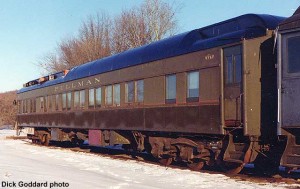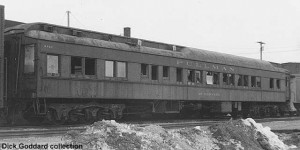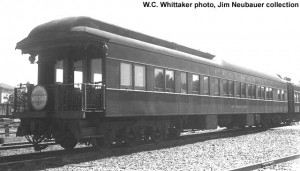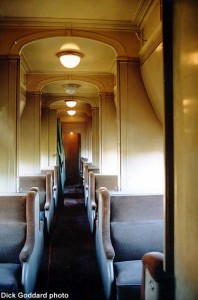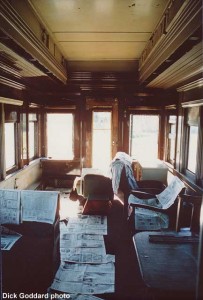Sleeper-Observation, Pullman Co., Lot 4742, Plan 3521, December 1923
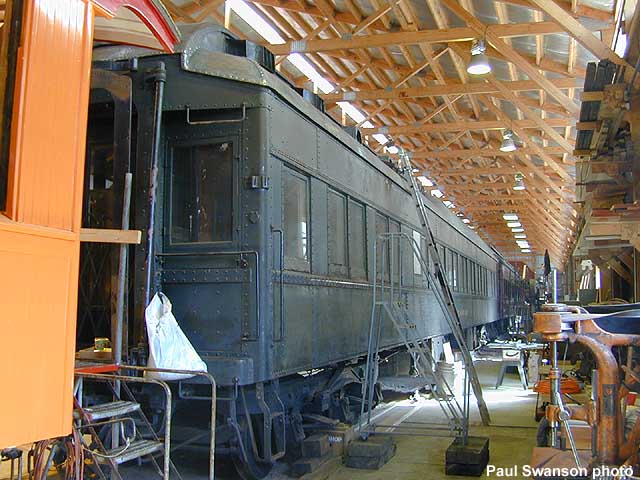
The Pullman Co. completed this heavyweight observation-sleeping car with ten sections, lounge, a women’s lavatory, and men’s smoking room and lavatory on December 7, 1923 at a cost of $32,587.76. The car was named “Mt. Harvard” as one of a group of fifteen identical cars comprising the “Mount” series. Beginning about 1920, Pullman practice called for naming identical series of cars with a common prefix or suffix (e.g. “Fort Adams,” “Mount Harvard,” and “Catskill Valley”). Pullman provided both the cars and staff to man them as a service to the major railroads, hence Pullman still owned the fleet of cars.
“Mt. Harvard” first saw service on the newly inaugurated Floridan on the Illinois Central, along with “Mt. Shasta” and other “Mount” series cars. In 1935, the car was equipped with air conditioning at Pullman’s plant at Chicago. On May 25, 1935, “Mt. Harvard” was assigned to service on the Southern Pacific. In 1939, its original floor plan was revised to Plan 3521-L with the enclosure of the open platform, addition of a buffet, and updated lounge appointments. The work took nearly three months at a cost of $13,383.44.
Mt. Harvard was built November 1923 to Pullman Plan 3521-L, Lot 4742. There were 70 cars built in the “Mt.” series to this Plan, but only 13 cars were built in the “Mount” series, to various configurations. The “Mt.” series was described as a 10-section Lounge Observation. In the book, “A Century of Puman Cars” Alphabetical List, by Ralph Barger, noted Pullman authority, when the Open Platform the car once bore was removed, the car was correctly identified as a 10-Section Buffet Lounge Solarium Observation.
The ladies’ lounge was forward in the car, then came the ten sections (five on each side), the men’s smoking room and Lavatory was next between the buffet and the lounge solarium observation room. The lounge had a seating capacity of 15. This included a table for four, a settee for two, and chairs for nine, separated by four tables for lamps.
The car had block ice air-conditioning, blow-fan activated.
While in its open-platform days, the car was reported to have operated on Southern Pacific’s line in the San Joaquin Valley as the set-out sleeper between Los Angeles and Sacramento. (The train, the West Coast, continued on its way to Portland.) The car was in Pullman-operated sleeper service. The car was sold to The Milwaukee Road, which ran its own sleeping car service, and shed its Pullman Green paint for Milwaukee orange and maroon. The car was staffed by Milwaukee personnel and not Pullman employees as Porters.
Mt. Harvard first ran on Milwaukee’s Columbian as the set-out sleeper between Chicago and Minneapolis. This service was superfluous. (The road also ran the Pioneer Limited overnight between these cities.) Mt. Harvard went west to perform the same set-out sleeper service between Seattle and Spokane each night on the Columbian.
When World War II restricted such short operations, this car was put into Government storage in Terre Haute, Indiana. When hostilities ended, it and sister car Mt.Cowan began service on the Arrow, Chicago to Savanna, Ill., where it was switched to the Milwaukee-to-Kansas City Southwest Ltd. overnighter. Residents of LeClaire, Iowa, called this the Kansas City Flyer when its F-6 class Hudson locomotive whistled through town, either keeping the bedroom community awake at night or waking them early in the morning.
In 1961, “Mt. Harvard” was donated to the Wabash Frisco & Pacific Association of St. Louis. Ten years later, it was sold to two Mid-Continent members and moved to Fond du Lac. It was resold to another member in 1972, and was shipped to North Freedom April 26, 1973. In 1987, “Mt. Harvard” was donated to Mid-Continent. Restoration was proposed in 1995 and minor work completed with the hopes of putting the car on public display and perhaps using it in Mid-Continent’s Dining Service trains; however, the project never gained traction.
This piece of equipment was deaccessioned in May 2015 as part of an effort to rationalize the museum’s collection. The equipment was deaccessioned in accordance with Mid-Continent Railway Museum’s Collection Policy. The sale of artifacts supports the preservation and accessibility of current collections or is used to acquire other, more appropriate artifacts to fulfill the museum mission. The Mt. Harvard was purchased by a private individual who then donated the car to Illinois Railway Museum in Union, IL.

